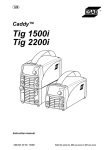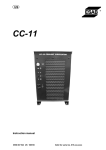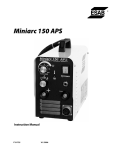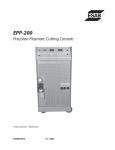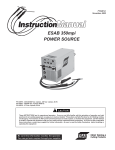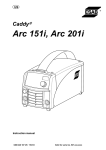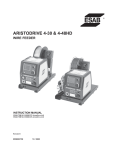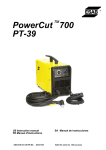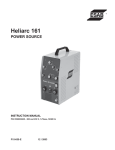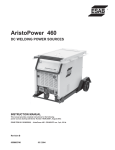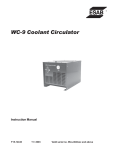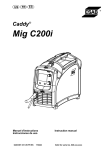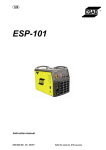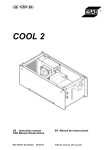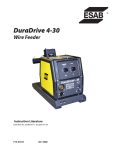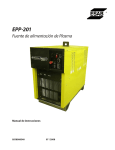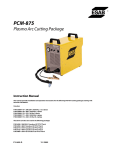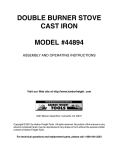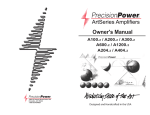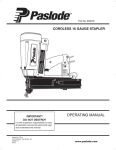Download EPP-360
Transcript
EPP-360 Instruction manual 0558 007 676 20110517 Valid for serial no. 015-xxx-xxxx 1 2 3 4 5 USER RESPONSIBILITY . . . . . . . . . . . . . . . . . . . . . . . . . . . . . . . . . . . . . . . . . . . . SAFETY PRECAUTIONS - English . . . . . . . . . . . . . . . . . . . . . . . . . . . . . . . . . . . PRECAUCION DE SEGURIDAD - Spanish . . . . . . . . . . . . . . . . . . . . . . . . . . . . MESURES DE SECURITE - French . . . . . . . . . . . . . . . . . . . . . . . . . . . . . . . . . . INTRODUCTION . . . . . . . . . . . . . . . . . . . . . . . . . . . . . . . . . . . . . . . . . . . . . . . . . . . 4 4 8 12 16 5.1 Features . . . . . . . . . . . . . . . . . . . . . . . . . . . . . . . . . . . . . . . . . . . . . . . . . . . . . . . . . . . . . . . . . 16 6 TECHNICAL DATA . . . . . . . . . . . . . . . . . . . . . . . . . . . . . . . . . . . . . . . . . . . . . . . . . 7 INSTALLATION . . . . . . . . . . . . . . . . . . . . . . . . . . . . . . . . . . . . . . . . . . . . . . . . . . . . 17 17 7.1 General . . . . . . . . . . . . . . . . . . . . . . . . . . . . . . . . . . . . . . . . . . . . . . . . . . . . . . . . . . . . . . . . . . 17 7.2 Unpacking . . . . . . . . . . . . . . . . . . . . . . . . . . . . . . . . . . . . . . . . . . . . . . . . . . . . . . . . . . . . . . . . 17 7.3 Placement . . . . . . . . . . . . . . . . . . . . . . . . . . . . . . . . . . . . . . . . . . . . . . . . . . . . . . . . . . . . . . . . 18 7.4 Input power connection . . . . . . . . . . . . . . . . . . . . . . . . . . . . . . . . . . . . . . . . . . . . . . . . . . . . . 18 7.4.1 Primary power . . . . . . . . . . . . . . . . . . . . . . . . . . . . . . . . . . . . . . . . . . . . . . . . . . . . . . . . 18 7.4.2 Input conductors . . . . . . . . . . . . . . . . . . . . . . . . . . . . . . . . . . . . . . . . . . . . . . . . . . . . . . 19 7.4.3 Input connection procedure . . . . . . . . . . . . . . . . . . . . . . . . . . . . . . . . . . . . . . . . . . . . 19 7.5 Output connections . . . . . . . . . . . . . . . . . . . . . . . . . . . . . . . . . . . . . . . . . . . . . . . . . . . . . . . . 20 7.5.1 Output cables (customer supplied) . . . . . . . . . . . . . . . . . . . . . . . . . . . . . . . . . . . . . . 20 7.5.2 Output connection procedure . . . . . . . . . . . . . . . . . . . . . . . . . . . . . . . . . . . . . . . . . . . 20 7.6 Parallel installation . . . . . . . . . . . . . . . . . . . . . . . . . . . . . . . . . . . . . . . . . . . . . . . . . . . . . . . . . 21 7.6.1 Connections for Two EPP -360’s in parallel . . . . . . . . . . . . . . . . . . . . . . . . . . . . . . . 21 7.6.2 Marking with two parallel EPP -360’s . . . . . . . . . . . . . . . . . . . . . . . . . . . . . . . . . . . . 23 7.7 Interface cable connectors . . . . . . . . . . . . . . . . . . . . . . . . . . . . . . . . . . . . . . . . . . . . . . . . . . 24 7.7.1 CNC interface cables with mating power source connector and unterminated CNC interface . . . . . . . . . . . . . . . . . . . . . . . . . . . . . . . . . . . . . . . . . . . . . . . . . . . . . . . . . . . . . . . . . 24 7.7.2 CNC interface cables with mating power source connectors at both ends . . . . . 25 7.7.3 Water cooler interface cables with mating power source connectors at both ends . . 25 7.7.4 Power source parallel control cable . . . . . . . . . . . . . . . . . . . . . . . . . . . . . . . . . . . . . . 26 8 OPERATION . . . . . . . . . . . . . . . . . . . . . . . . . . . . . . . . . . . . . . . . . . . . . . . . . . . . . . . 27 8.1 EPP-360 Block Diagram . . . . . . . . . . . . . . . . . . . . . . . . . . . . . . . . . . . . . . . . . . . . . . . 27 8.2 Control panel . . . . . . . . . . . . . . . . . . . . . . . . . . . . . . . . . . . . . . . . . . . . . . . . . . . . . . . . . . . . . 28 8.3 Modes of operation . . . . . . . . . . . . . . . . . . . . . . . . . . . . . . . . . . . . . . . . . . . . . . . . . . . . . . . . 30 8.3.1 4.3.1. Single power source (used with the CNC, two basic modes of operation are possible) . . . . . . . . . . . . . . . . . . . . . . . . . . . . . . . . . . . . . . . . . . . . . . . . . . . . . . . . . . . . . . . . 30 8.3.2 Multiple power sources . . . . . . . . . . . . . . . . . . . . . . . . . . . . . . . . . . . . . . . . . . . . . . . . 33 8.4 Sequence of operation . . . . . . . . . . . . . . . . . . . . . . . . . . . . . . . . . . . . . . . . . . . . . . . . . . . . . 33 9 MAINTENANCE . . . . . . . . . . . . . . . . . . . . . . . . . . . . . . . . . . . . . . . . . . . . . . . . . . . . 34 9.1 General . . . . . . . . . . . . . . . . . . . . . . . . . . . . . . . . . . . . . . . . . . . . . . . . . . . . . . . . . . . . . . . . . . 9.2 Cleaning . . . . . . . . . . . . . . . . . . . . . . . . . . . . . . . . . . . . . . . . . . . . . . . . . . . . . . . . . . . . . . . . . 34 34 10 TROUBLESHOOTING . . . . . . . . . . . . . . . . . . . . . . . . . . . . . . . . . . . . . . . . . . . . . . 35 10.1 Troubleshooting guide . . . . . . . . . . . . . . . . . . . . . . . . . . . . . . . . . . . . . . . . . . . . . . . . . . . . . . 10.2 Help code list . . . . . . . . . . . . . . . . . . . . . . . . . . . . . . . . . . . . . . . . . . . . . . . . . . . . . . . . . . . . . 10.3 Fault Isolation . . . . . . . . . . . . . . . . . . . . . . . . . . . . . . . . . . . . . . . . . . . . . . . . . . . . . . . . . . . . . 10.3.1 Fans not working . . . . . . . . . . . . . . . . . . . . . . . . . . . . . . . . . . . . . . . . . . . . . . . . . . . . . 10.3.2 Torch will not fire . . . . . . . . . . . . . . . . . . . . . . . . . . . . . . . . . . . . . . . . . . . . . . . . . . . . . 35 36 37 37 37 11 REPLACEMENT PARTS . . . . . . . . . . . . . . . . . . . . . . . . . . . . . . . . . . . . . . . . . . . . 38 11.1 General . . . . . . . . . . . . . . . . . . . . . . . . . . . . . . . . . . . . . . . . . . . . . . . . . . . . . . . . . . . . . . . . . . 11.2 Ordering . . . . . . . . . . . . . . . . . . . . . . . . . . . . . . . . . . . . . . . . . . . . . . . . . . . . . . . . . . . . . . . . . 38 38 Rights reserved to alter specifications without notice. TOCa -2- 12 REVISION HISTORY . . . . . . . . . . . . . . . . . . . . . . . . . . . . . . . . . . . . . . . . . . . . . . . . SCHEMATIC DIAGRAM . . . . . . . . . . . . . . . . . . . . . . . . . . . . . . . . . . . . . . . . . . . . . . . . REPLACEMENT PARTS . . . . . . . . . . . . . . . . . . . . . . . . . . . . . . . . . . . . . . . . . . . . . . . Rights reserved to alter specifications without notice. TOCa -3- 38 40 49 US Be sure this information reaches the operator. You can get extra copies through your supplier. These INSTRUCTIONS are for experienced operators. If you are not fully familiar with the principles of operation and safe practices for arc welding equipment, we urge you to read our booklet, “Precations and Safe Practices for Arc, Cutting and Gouging, “Form 52-529. Do NOT permit untrained persons to install, operate, or maintain this equipment. Do NOT attempt to install or operate this equipment until you have read and fully understand these instructions. If you do not fully understand these instructions, contact your supplier for further information. Be sure to read the Safety Precautions before installing or operating this equipment. 1 USER RESPONSIBILITY This equipment will perform in conformity with the description thereof contained in this manual and accompanying labels and/or insert when installed, operated, maintained and repaired in accordance with the instruction provided. This equipment must be checked periodically. Malfunctioning or poorly maintained equipment should not be used. Parts that are broken, missing, worn, distorted or contaminated should be replaced immediately. Should such repair or replacement become necessary, the manufacturer recommends that a telephone or written request for service advice be made to the Authorized Distributor from whom it was purchased. This equipment or any of its parts should not be altered without the prior written approval of the manufacturer. The user of this equipment shall have the sole responsibility for any malfunction which results from improper use, faulty maintenance, damage improper repair or alteration by anyone other than the manufacturer or a service facility designated by the manufacturer. 2 SAFETY PRECAUTIONS - English WARNING: These Safety Precautions are for your protection. They summarize precautionary information from the references listed in Additional Safety Information section. Before performing any installation or operating procedures, be sure to read and follow the safety precautions listed below as well as all other manuals, material safety data sheets, labels, etc. Failure to observe Safety Precautions can result in injury or death. PROTECT YOURSELF AND OTHERS Some welding, cutting and gouging precesses are noisy and require ear protection. The arc, like the sun, emits ultraviolet (UV) and other radiation and can injure skin and eyes. Hot metal can cause burns. Training in the proper use of the processes and equipment is essential to prevent accidents. Therefore: 1. Always wear safety glasses with side shields in any work area, even if welding helmets face shields and goggles are also required. 2. Use a face shield fitted with the correct filter and cover plates to protect your eyes, face, neck and ears from sparks and rays of the arc when operating or observing operations. Warn bystanders not to watch the arc and not to expose themselves to the rays of the electric-arc or hot metal. 3. Wear flameproof gauntlet type gloves, heavy long-sleeve shirt, cuffless trousers, high-topped shoes and a welding helmet or cap for protection, to protect against arc rays and hot sparks or hot metal. A flameproof apron may also be desirable as protection against radiated heat and sparks. US warnings -4- © ESAB AB 2010 US 4. Hot sparks or metal can lodge in rolled up sleeves, trouser cuffs, or pockets. Sleeves and collars should be kept buttoned and open pockets eliminated from the front of clothing. 5. Protect other personnel from arc rays and hot sparks with a suitable nonflammable partition or curtains. 6. Use goggles over safety glasses when chipping slag or grinding. Chipped slag may be hot and can fly far. Bystanders should also wear goggles over safety glasses. FIRES AND EXPLOSIONS Heat from flames and arcs can start fires. Hot slag or sparks can also cause fires and explosions. Therefore: 1. Remove all combustible materials well away from the work area or cover the materials with a protective nonflammable covering. Combusible materials include wood, clot, sawdust, liquid and gas fuels, solvents, pants and coatings papper, etc. 2. Hot sparks or hot metal can fall through cracks or crevices in floors or wall openings and cause a hidden smoldering fire or fires on the floor below. Make certain that such openings are protected from hot sparks and metal. 3. Do not weld, cut or perform other hot work until the workpiece has been completely cleaned so that there are no substances on the workpiece which might produce flammable or toxic vapors. Do not do hot work on closed containers. They may explode. 4. Have fire extinguishing equipment handy for instant use, such as a garden hose, water pail, sand bucket, or portable fire extinguisher. Be sure you are trained in its use. 5. Do not use equipment beyond its ratings. For example, overloaded welding cable can overheat and create a fire hazard. 6. After completing operations, inspect the work area to make certain there are no hot sparks or hot metal which could cause a later fire. Use fire watchers when necessary. 7. For additional information refer to NFPA Standard 51B, “Fire Prevention in Use of Cutting and Welding Processes”, available from the National Fire Protection Association, Batterymarch Park, Quincy, MA 02269. ELECTRICAL SHOCK Contact with live electrical parts and ground can cause severe injury or death. DO NOT use AC welding current in damp areas, if movement is confined, or if there is danger of falling. Therefore: 1. Be sure the power source frame (chassis) is connected to the ground system of the input power. 2. Connect the workpiece to a good electrical ground. 3. Connect the work cable to the workpiece. A poor or missing connection can expose you or others to a fatal shock. 4. Use well-maintained equipment. Replace worn or damaged cables. 5. Keep everything dry, including clothing, work area, cables, torch/electrode holder and power source. 6. Make sure that all parts of your bady are insulated from work and from ground. 7. Do not stand directly on metal or the earth while working in tight quarters or a damp area; stand on dry boards or an insulating platform and wear rubber-soled shoes. 8. Put on dry, hole-free gloves before turning on the power. 9. Turn off the power before removing your gloves. 10. Refer to ANSI/ASC Standard Z49.1 (listed on next page) for specific grounding recommendations. Do not mistake the work lead for a ground cable. US warnings -5- © ESAB AB 2010 US ELECTRIC AND MAGNETIC FIELDS May be dangerous. Electric current flowing through any conductor causes localized Electric and Magnetic Fields (EMF). Welding and cutting current creates EMF around welding cables and welding machines. Therefore: 1. Welders having pacemakers should consult their physician before welding. EMF may interfere with some pacemakers. 2. Exposure to EMF may have other health effects which are unknown. 3. Welders should use the following procedures to minimize exposure to EMF: a. Route the electrode and work cables together. Secure them with tape when possible. b. Never coil the torch or work cable around your body. c. Do not place your body between the torch and work cables. Route cables on the same side of your body. d. Connect the work cable to the workpiece as close as possible to the area being welded. e. Keep welding power source and cables as far away from your body as possible. FUMES AND GASES Fumes and gases, can cause discomfort or harm, particularly in confined spaces. Do not breathe fumes and gases. Shielding gases can cause asphyxiation. Therfore: 1. Always provide adequate ventilation in the work area by natural or mechanical means. Do not weld, cut or gouge on materials such as galvanized steel, stainless steel, cooper, zinc, lead beryllium or cadmium unless positive mechanical ventilation is provided. Do not breathe fumes from these materials. 2. Do not operate near degreasing and spraying operations. The heat or arc can react with chlorinated hydrocarbon vapors to form phosgene, a highly toxic gas and other irritant gases. 3. If you develop momentary eye, nose or throat irritation while operating, this is an indication that ventilation is not adequate. Stop work and take necessary steps to improve ventilation in the work area. Do not continue to operate if physical discomfort persists. 4. Refer to ANSI/ASC Standard Z49.1 (see listing below) for specific ventilation recommendations. 5. WARNING: This product when used for welding or cutting, produces fumes or gases which contain chemicals known to the State of Californa to cause birth defects and in some cases cancer (California Health & Safety Code §25249.5 et seq.) CYLINDER HANDLING Cylinders, if mishandled, can rupture and violently release gas. Sudden rupture of cylinder valve or relief device can injure or kill. Therefore: 1. Use the proper gas for the process and use the proper pressure reducing regulator designed to operate from the compressed gas cylinder. Do not use adaptors. Maintain hoses and fittings in good condition. Follow manufacturer's operating instructions for mounting regulator to a compressed gas cylinder. 2. Always secure cylinders in an upright position by chain or strap to suitable hand trucks, undercarriages, benches, wall, post or racks. Never secure cylinders to work tables or fixtures where they may become part of an electrical circuit. 3. When not in use, keep cylinder valves closed. Have valve protection cap in place if regulator is not connected. Secure and move cylinders by using suitable hand trucks. 4. Locate cylinders away from heat, sparks and flames. Never strike an arc on a cylinder. 5. For additional information, refer to CGA Standard P-1, “Precations for Safe Handling of Comporessed Gases in Cylinders”, which is available from Compressed Gas Association, 1235 Jefferson Davis Highway, Arlington, VA 22202. US warnings -6- © ESAB AB 2010 US EQUIPMENT MAINTENANCE Faulty or improperly maintained equipment can cause injury or death. Therefore: 1. Always have qualified personnel perform the installaion, troubleshooting and maintenance work. Do not perform any electrical work unless you are qualified to perform such work. 2. Before performing any maintenance work inside a power source, disconnect the power source from the incoming electrical power. 3. Maintain cables, grounding wire, connections, power cord and power supply in safe working order. Do not operate any equipment in faulty condition. 4. Do not abuse any equipment or accessories. Keep equipment away from heat sources such as furnaces, wet conditions such as water puddles, oil or grease, corrosive atmospheres and inclement weather. 5. Keep all safety devices and cabinet covers in position and in good repair. 6. Use equipment only for its intended purpose. Do not modify it in any manner. ADDITIONAL SAFETY INFORMATION For more information on safe practices for electric arc welding and cutting equipment, ask your supplier for a copy of “Precautions and Safe Practices for Arc Welding, Cutting and Gouging”, Form 52-529. The following publications, which are available from the American Welding Society, 550 N.W. LeJuene Road, Miami, FL 33126, are recommended to you: 1. 2. 3. 4. 5. 6. 7. 8. ANSI/ASC Z49.1 - “Safety in Welding and Cutting” AWS C5.1 . “Recommended Practices for Plasma Arc Welding” AWS C5.2 - “Recommended Practices for Plasma Arc Cutting“ AWS C5.3 - “Recommended Practices for Air Carbon, Arc Gouging and Cutting” AWS C5.5 - “Recommended Practices for Gas Tungsten Arc Welding” AWS C5.6 - “Recommended Practices for Gas Metal Arc welding” AWS SP - “Safe practices” - Reprint, Welding Handbook ANSI/AWS F4.1 - “Recommended Safe Practices for Welding and Cutting of Containers That Have Held Hazardous Substances” MEANING OF SYMBOLS As used throughout this manual: Means Attention! Be Alert! Means immediate hazards which, if not avoided, will result in immediate, serious personal injury or loss of life. Means potential hazards which could result in personal injury or loss of life. Means hazards which could result in minor personal injury. US warnings -7- © ESAB AB 2010 US 3 PRECAUCION DE SEGURIDAD - Spanish ADVERTENCIA: Estas Precauciones de Seguridad son para su protección. Ellas hacen resumen de información proveniente de las referencias listadas en la sección ”Información Adicional Sobre La Seguridad”. Antes de hacer cualquier instalación o procedimiento de operación, asegúrese de leer y seguir las precauciones de seguridad listadas a continuación así como también todo manual, hoja de datos de seguridad del material, calcomanias, etc. El no observar las Precauciones de Seguridad puede resultar en daño a la persona o muerte. PROTEJASE USTED Y A LOS DEMAS Algunos procesos de soldadura, corte y ranurado son ruidosos y requiren protección para los oídos. El arco, como el sol , emite rayos ultravioleta (UV) y otras radiaciones que pueden dañar la piel y los ojos. El metal caliente causa quemaduras. EL entrenamiento en el uso propio de los equipos y sus procesos es esencial para prevenir accidentes. Por lo tanto: 1. Utilice gafas de seguridad con protección a los lados siempre que esté en el área de trabajo, aún cuando esté usando careta de soldar, protector para su cara u otro tipo de protección. 2. Use una careta que tenga el filtro correcto y lente para proteger sus ojos, cara, cuello, y oídos de las chispas y rayos del arco cuando se esté operando y observando las operaciones. Alerte a todas las personas cercanas de no mirar el arco y no exponerse a los rayos del arco eléctrico o el metal fundido. 3. Use guantes de cuero a prueba de fuego, camisa pesada de mangas largas, pantalón de ruedo liso, zapato alto al tobillo, y careta de soldar con capucha para el pelo, para proteger el cuerpo de los rayos y chispas calientes provenientes del metal fundido. En ocaciones un delantal a prueba de fuego es necesario para protegerse del calor radiado y las chispas. 4. Chispas y partículas de metal caliente puede alojarse en las mangas enrolladas de la camisa, el ruedo del pantalón o los bolsillos. Mangas y cuellos deberán mantenerse abotonados, bolsillos al frente de la camisa deberán ser cerrados o eliminados. 5. Proteja a otras personas de los rayos del arco y chispas calientes con una cortina adecuada no-flamable como división. 6. Use careta protectora además de sus gafas de seguridad cuando esté removiendo escoria o puliendo. La escoria puede estar caliente y desprenderse con velocidad. Personas cercanas deberán usar gafas de seguridad y careta protectora. FUEGO Y EXPLOSIONES El calor de las flamas y el arco pueden ocacionar fuegos. Escoria caliente y las chispas pueden causar fuegos y explosiones. Por lo tanto: 1. Remueva todo material combustible lejos del área de trabajo o cubra los materiales con una cobija a prueba de fuego. Materiales combustibles incluyen madera, ropa, líquidos y gases flamables, solventes, pinturas, papel, etc. 2. Chispas y partículas de metal pueden introducirse en las grietas y agujeros de pisos y paredes causando fuegos escondidos en otros niveles o espacios. Asegúrese de que toda grieta y agujero esté cubierto para proteger lugares adyacentes contra fuegos. 3. No corte, suelde o haga cualquier otro trabajo relacionado hasta que la pieza de trabajo esté totalmente limpia y libre de substancias que puedan producir gases inflamables o vapores tóxicos. No trabaje dentro o fuera de contenedores o tanques cerrados. Estos pueden explotar si contienen vapores inflamables. 4. Tenga siempre a la mano equipo extintor de fuego para uso instantáneo, como por ejemplo una manguera con agua, cubeta con agua, cubeta con arena, o extintor portátil. Asegúrese que usted esta entrenado para su uso. 5. No use el equipo fuera de su rango de operación. Por ejemplo, el calor causado por cable sobrecarga en los cables de soldar pueden ocasionar un fuego. 6. Después de termirar la operación del equipo, inspeccione el área de trabajo para cerciorarse de que las chispas o metal caliente ocasionen un fuego más tarde. Tenga personal asignado para vigilar si es necesario. US warnings -8- © ESAB AB 2010 US 7. Para información adicional , haga referencia a la publicación NFPA Standard 51B, “Fire Prevention in Use of Cutting and Welding Processes”, available from the National Fire Protection Association, Batterymarch Park, Quincy, MA 02269. CHOQUE ELECTRICO El contacto con las partes eléctricas energizadas y tierra puede causar daño severo o muerte. NO use soldadura de corriente alterna (AC) en áreas húmedas, de movimiento confinado en lugares estrechos o si hay posibilidad de caer al suelo. Por lo tanto: 1. Asegúrese de que el chasis de la fuente de poder esté conectado a tierra através del sistema de electricidad primario. 2. Conecte la pieza de trabajo a un buen sistema de tierra física. 3. Conecte el cable de retorno a la pieza de trabajo. Cables y conductores expuestos o con malas conexiones pueden exponer al operador u otras personas a un choque eléctrico fatal. 4. Use el equipo solamente si está en buenas condiciones. Reemplaze cables rotos, dañados o con conductores expuestos. 5. Mantenga todo seco, incluyendo su ropa, el área de trabajo, los cables, antorchas, pinza del electrodo, y la fuente de poder. 6. Asegúrese que todas las partes de su cuerpo están insuladas de ambos, la pieza de trabajo y tierra. 7. No se pare directamente sobre metal o tierra mientras trabaja en lugares estrechos o áreas húmedas; trabaje sobre un pedazo de madera seco o una plataforma insulada y use zapatos con suela de goma. 8. Use guantes secos y sin agujeros antes de energizar el equipo. 9. Apage el equipo antes de quitarse sus guantes. 10. RUse como referencia la publicación ANSI/ASC Standard Z49.1 (listado en la próxima página) para recomendaciones específicas de como conectar el equipo a tierra. No confunda el cable de soldar a la pieza de trabajo con el cable a tierra. CAMPOS ELECTRICOS Y MAGNETICOS Son peligrosos. La corriente eléctrica fluye através de cualquier conductor causando a nivel local Campos Eléctricos y Magnéticos (EMF). Las corrientes en el área de corte y soldadura, crean EMF alrrededor de los cables de soldar y las maquinas. Por lo tanto: 1. Soldadores u Operadores que use marca-pasos para el corazón deberán consultar a su médico antes de soldar. El Campo Electromagnético (EMF) puede interferir con algunos marcapasos. 2. Exponerse a campos electromagnéticos (EMF) puede causar otros efectos de salud aún desconocidos. 3. Los soldadores deberán usar los siguientes procedimientos para minimizar exponerse al EMF: a. Mantenga el electrodo y el cable a la pieza de trabajo juntos, hasta llegar a la pieza que usted quiere soldar. Asegúrelos uno junto al otro con cinta adhesiva cuando sea posible. b. Nunca envuelva los cables de soldar alrededor de su cuerpo. c. Nunca ubique su cuerpo entre la antorcha y el cable, a la pieza de trabajo. Mantega los cables a un sólo lado de su cuerpo. d. Conecte el cable de trabajo a la pieza de trabajo lo más cercano posible al área de la soldadura. e. Mantenga la fuente de poder y los cables de soldar lo más lejos posible de su cuerpo. US warnings -9- © ESAB AB 2010 US HUMO Y GASES El humo y los gases, pueden causar malestar o daño, particularmente en espacios sin ventilación. No inhale el humo o gases. El gas de protección puede causar falta de oxígeno. Por lo tanto: 1. Siempre provea ventilación adecuada en el área de trabajo por medio natural o mecánico. No solde, corte, o trabajo por medio natural o mecánico. No solde, corte, o ranure materiales con hierro galvanizado, acero inoxidable, cobre, zinc, plomo, berílio, o cadmio a menos que provea ventilación mecánica positiva. No respire los gases producidos por estos materiales. 2. No opere cerca de lugares donde se aplique substancias químicas en aerosol. El calor de los rayos del arco pueden reaccionar con los vapores de hidrocarburo clorinado para formar un fosfógeno, o gas tóxico, y otros irritant es. 3. Si momentáneamente desarrolla inrritación de ojos, nariz o garganta mientras est á operando, es indicación de que la ventilación no es apropiada. Pare de trabajar y tome las medidas necesarias para mejorar la ventilación en el área de trabajo. No continúe operando si el malestar físico persiste. 4. Haga referencia a la publicación ANSI/ASC Standard Z49.1 (Vea la lista a continuación) para recomendaciones específicas en la ventilación. 5. ADVERTENCIA-Este producto cuando se utiliza para soldaduras o cortes, produce humos o gases, los cuales contienen químicos conocidos por el Estado de California de causar defectos en el nacimiento, o en algunos casos, Cancer. (California Health & Safety Code §25249.5 et seq.) MANEJO DE CILINDROS Los cilindros, si no son manejados correctamente, pueden romperse y liberar violentamente gases. Rotura repentina del cilindro, válvula, o válvula de escape puede causar daño o muerte. Por lo tanto: 1. Utilize el gas apropiado para el proceso y utilize un regulador diseñado para operar y reducir la presión del cilindro de gas. No utilice adaptadores. Mantenga las mangueras y las conexiones en buenas condiciones. Observe las instrucciones de operación del manufacturero para montar el regulador en el cilindro de gas comprimido. 2. Asegure siempre los cilindros en posición vertical y amárrelos con una correa o cadena adecuada para asegurar el cilindro al carro, transportes, tablilleros, paredes, postes, o armazón. Nunca asegure los cilindros a la mesa de trabajo o las piezas que son parte del circuito de soldadura. Este puede ser parte del circuito elélectrico. 3. Cuando el cilindro no está en uso, mantenga la válvula del cilindro cerrada. Ponga el capote de protección sobre la válvula si el regulador no está conectado. Asegure y mueva los cilindros utilizando un carro o transporte adecuado. Evite el manejo brusco de los 4. Localize los cilindros lejos del calor, chispas, y flamas. Nunca establezca un arco en el cilindro. 5. Para información adicional, haga referncia a la publicación CGA Standard P-1, “Precations for Safe Handling of Comporessed Gases in Cylinders”, disponible através del Compressed Gas Association, 1235 Jefferson Davis Highway, Arlington, VA 22202. MANTENIMIENTO DEL EQUIPO Equipo defectuoso o mal mantenido puede causar daño o muerte. Por lo tanto: 1. Siempre tenga personal cualificado para efectuar la instalación, diagnóstico, y mantenimiento del equipo. No ejecute ningún trabajo eléctrico a menos que usted esté cualificado para hacer el trabajo. 2. Antes de dar mantenimiento en el interior de la fuente de poder, desconecte la fuente de poder del suministro de electricidad primaria. 3. Mantenga los cables, cable a tierra, conexciones, cable primario, y cualquier otra fuente de poder en buen estado operacional. No opere ningún equipo en malas condiciones. 4. No abuse del equipo y sus accesorios. Mantenga el equipo lejos de cosas que generen calor como hornos, también lugares húmedos como charcos de agua, aceite o grasa, atmósferas corrosivas y las inclemencias del tiempo. 5. Mantenga todos los artículos de seguridad y coverturas del equipo en su posición y en buenas condiciones. US warnings - 10 - © ESAB AB 2010 US 6. Use el equipo sólo para el propósito que fue diseñado. No modifique el equipo en ninguna manera. INFORMACION ADICIONAL DE SEGURIDAD Para más información sobre las prácticas de seguridad de los equipos de arco eléctrico para soldar y cortar, pregunte a su suplidor por una copia de “Precautions and Safe Practices for Arc Welding, Cutting and Gouging”, Form 52-529. Las siguientes publicaciones, disponibles através de la American Welding Society, 550 N.W. LeJuene Road, Miami, FL 33126, son recomendadas para usted: 1. 2. 3. 4. 5. 6. 7. 8. ANSI/ASC Z49.1 - “Safety in Welding and Cutting” AWS C5.1 . “Recommended Practices for Plasma Arc Welding” AWS C5.2 - “Recommended Practices for Plasma Arc Cutting“ AWS C5.3 - “Recommended Practices for Air Carbon, Arc Gouging and Cutting” AWS C5.5 - “Recommended Practices for Gas Tungsten Arc Welding” AWS C5.6 - “Recommended Practices for Gas Metal Arc welding” AWS SP - “Safe practices” - Reprint, Welding Handbook ANSI/AWS F4.1 - “Recommended Safe Practices for Welding and Cutting of Containers That Have Held Hazardous Substances” SIGNIFICADO DE LOS SIMBOLOS Según usted avanza en la lectura de este folleto: Los Símbolos Significan ¡Atención! ¡Esté Alerta! Se trata de su seguridad. Significa riesgo inmediato que, de no ser evadido, puede resultar inmediatamente en serio daño personal o la muerte. Significa el riesgo de un peligro potencial que puede resultar en serio daño personal o la muerte. Significa el posible riesgo que puede resultar en menores daños a la persona. US warnings - 11 - © ESAB AB 2010 US 4 MESURES DE SECURITE - French ATTENTION : ces règles de sécurité ont pour objet d'assurer votre protection. Elles constituent une synthèse des mesures de sécurité contenues dans les ouvrages de référence repris au chapitre Informations complémentaires relatives à la Sécurité. Avant toute installation ou utilisation du matériel, veillez à lire et à respecter les règles de sécurité énoncées ci-dessous ainsi que dans les divers manuels, fiches de sécurité du matériel, étiquettes, etc. Le non-respect de ces précautions risque d'entraîner des blessures graves ou mortelles. PROTECTION INDIVIDUELLE ET DE L'ENTOURAGE Certains procédés de soudage, découpage et gougeage sont bruyants et requièrent le port de protections auditives. L'arc, tout comme le soleil, émet des ultraviolets (UV) et d'autres rayonnements susceptibles de provoquer des lésions oculaires et dermatologiques. Le métal chaud peut être à l'origine de brûlures. Une formation à l'utilisation correcte des procédés et équipements est essentielle pour prévenir les accidents. En conséquence : 1. Porter impérativement des lunettes avec écrans latéraux dans les zones de travail, même lorsque le port du casque de soudage, de l'écran facial et des lunettes de protection est obligatoire 2. Tant pour exécuter les travaux que pour y assister, porter un écran facial muni de plaques protectrices et de verres filtrants appropriés pour protéger les yeux, le visage, le cou et les oreilles des étincelles et du rayonnement de l'arc. Avertir les personnes se trouvant à proximité qu'elles ne doivent pas regarder l'arc, ni s'exposer à son rayonnement ou à celui du métal incandescent. 3. Porter des gants ignifuges à crispins, une tunique épaisse à longues manches, des pantalons sans rebord, des chaussures à embout d'acier et un casque de soudage ou une casquette pour se protéger du rayonnement de l'arc, des étincelles et du métal incandescent. Le port d'un tablier ininflammable est également recommandé afin de se protéger des étincelles et du rayonnement thermique. 4. Les étincelles ou projections de métal en fusion risquent de se loger dans les manches retroussées, les bords relevés de pantalons ou dans les poches. Il convient donc de boutonner complètement les manches et le col, et de porter des vêtements sans poches à l'avant. 5. Protéger du rayonnement de l'arc et des étincelles les personnes se trouvant à proximité à l'aide d'un écran ou d'un rideau ininflammable approprié. 6. Porter des oculaires et des lunettes de protection pendant le meulage du laitier. Les particules meulées, souvent brûlantes, peuvent être projetées à des distances importantes, de sorte que les personnes se trouvant à proximité doivent également porter des lunettes de protection. INCENDIES ET EXPLOSIONS La chaleur dégagée par les flammes et les arcs peuvent être à l'origine d'incendies. Le laitier incandescent et les étincelles peuvent également provoquer incendies et explosions. En conséquence : 1. Éloigner suffisamment tous les matériaux combustibles de la zone de travail ou les recouvrir complètement d'une bâche ignifuge. Ce type de matériaux comprend le bois, les vêtements, la sciure, les carburants sous forme liquide et gazeuse, les peintures, les enduits, le papier, etc. 2. Les étincelles ou projections de métal en fusion peuvent tomber dans les fissures du sol ou des murs et déclencher une combustion lente dans les planchers ou à l'étage inférieur. Veiller à protéger ces ouvertures pour que les étincelles et projections n'y pénètrent pas. 3. Ne pas procéder à des travaux de soudage, de découpage et autres travaux à chaud tant que la surface n'est pas complètement nettoyée et débarrassée des substances susceptibles de produire des vapeurs inflammables ou toxiques. Ne pas effectuer de travaux à chaud sur des conteneurs fermés pour éviter tout risque d'explosion. 4. Conserver à portée de main un équipement d'extinction – tuyau d'arrosage, seau d'eau ou de sable, extincteur portatif, etc. et s'assurer d'en connaître l'utilisation. 5. Ne pas utiliser l'équipement au-delà de ses spécifications. Par exemple, un câble de soudage surchargé est susceptible de surchauffer et d'être à l'origine d'un incendie. US warnings - 12 - © ESAB AB 2010 US 6. Une fois le travail terminé, inspecter la zone de travail pour s'assurer qu'aucune étincelle ou projection de métal ne risque de déclencher un incendie. Le cas échéant, utiliser des systèmes de détection d'incendie. 7. Pour toute information supplémentaire, voir la norme NFPA 51B relative à la prévention des incendies lors de travaux de découpage et de soudage, disponible auprès de la National Fire Protection Association, Batterymarch Park, Quincy, MA 02269 – USA. CHOC ELECTRIQUE Tout contact avec des éléments sous tension et la masse peut provoquer des blessures graves ou mortelles. NE PAS utiliser de courant de soudage CA dans des zones humides, des lieux exigus ou lorsqu'il existe un risque de chute. En conséquence : 1. Vérifier que le châssis du générateur est bien relié au dispositif de mise à la masse de l'alimentation. 2. Assurer une mise à la masse correcte de la pièce à souder. 3. Connecter le câble de soudage à la pièce à souder. Un raccordement médiocre ou inexistant constitue un risque mortel pour l'utilisateur et son entourage. 4. Utiliser du matériel correctement entretenu. Remplacer les câbles usés ou endommagés. 5. Empêcher l'apparition de toute humidité, notamment sur les vêtements, dans la zone de travail, sur les câbles, la torche de soudage, le porte-électrode et le générateur. 6. S'assurer que le corps est totalement isolé de la pièce à souder et de la masse. 7. Éviter tout contact direct avec du métal ou la masse lors de travaux dans des endroits exigus et en zone humide ; se tenir sur des panneaux ou sur une plate-forme isolante et porter des chaussures à semelles en caoutchouc. 8. Enfiler des gants secs et sans trous avant de mettre l'équipement sous tension. 9. Mettre l'équipement hors tension avant de retirer les gants. 10. Voir la norme ANSI/ASC Z49.1 (voir page suivante) pour les recommandations de mise à la masse. Ne pas confondre le câble de soudage et le câble de masse. CHAMPS ELECTRIQUES ET MAGNETIQUES Danger. Le courant électrique parcourant les conducteurs génère localement des champs électriques et magnétiques (EMF). Le courant de soudage et de découpe crée des EMF autour des câbles de soudage et des postes à souder. En conséquence : 1. Les porteurs de stimulateurs cardiaques consulteront leur médecin avant d'effectuer des travaux de soudage. Les EMF peuvent en effet provoquer des interférences. 2. L'exposition aux EMF peut également avoir des effets méconnus sur la santé. 3. Les soudeurs respecteront les procédures suivantes pour réduire l'exposition aux EMF : a. Rassembler en faisceau les câbles de soudage et d'électrode. Si possible, les attacher avec du ruban adhésif. b. Ne jamais enrouler le câble de la torche ou le câble de soudage autour du corps. c. L'utilisateur ne doit jamais se trouver entre le câble de la torche et le câble de soudage. Faire passer tous les câbles du même côté du corps. d. Connecter le câble de soudage à la pièce à souder, au plus près de l'endroit du soudage. e. S'éloigner au maximum du générateur et des câbles. US warnings - 13 - © ESAB AB 2010 US 1. 2. 3. 4. 5. 1. 2. 3. 4. 5. 1. 2. 3. 4. 5. 6. FUMEES ET GAZ L'inhalation des fumées et gaz peut provoquer des malaises et des dommages corporels, surtout lors de travaux dans les espaces confinés. Ne pas les respirer. Les gaz inertes peuvent causer l'asphyxie. En conséquence : Assurer une aération adéquate de la zone de travail par une ventilation naturelle ou mécanique. Ne pas effectuer de travaux de soudage, découpage ou gougeage sur des matériaux tels que l'acier galvanisé, le cuivre, le zinc, le plomb, le béryllium et le cadmium en l'absence d'une ventilation mécanique adéquate. Ne pas inhaler les fumées dégagées par ces matériaux. Ne pas travailler à proximité d'opérations de dégraissage et de pulvérisation étant donné que la chaleur dégagée et l'arc peut réagir avec les hydrocarbures chlorés pour former du phosgène – un gaz particulièrement toxique – et d'autres gaz irritants. Une irritation momentanée des yeux, du nez ou de la gorge provoquée par les travaux est le signe d'une ventilation inappropriée. Dans ce cas, il convient d'arrêter le travail et de prendre les mesures nécessaires pour améliorer l'aération. Ne pas poursuivre le travail si le malaise persiste. Voir la norme ANSI/ASC Z49.1 (voir ci-dessous) pour les recommandations de ventilation. ATTENTION : utilisé dans des opérations de soudage et de découpage, ce produit dégage des fumées et gaz qui contiennent des substances chimiques reconnues par l'État de Californie comme pouvant être à l'origine de malformations congénitales et de cancers (California Health & Safety Code §25249.5 et seq.). MANIPULATION DES BOUTEILLES DE GAZ Une erreur de manutention des bouteilles de gaz peut les endommager et entraîner une libération violente du gaz. La rupture soudaine de la soupape ou du détendeur peut provoquer des blessures graves ou mortelles. En conséquence : Utiliser le gaz approprié à la pression adéquate, celle-ci étant réglée par un détendeur adapté au type de bouteille utilisée. Ne pas utiliser d'adaptateurs. Garder les tuyaux et accessoires en bon état. Pour le montage du détendeur sur une bouteille de gaz comprimé, suivre les instructions du fabricant. Fixer les bouteilles verticalement – au moyen d'une chaîne ou d'une sangle – à un chariot à bras, un châssis de roulement, un banc, un mur, un piquet ou un rack. Ne jamais attacher les bouteilles aux établis et éléments susceptibles de les intégrer à un circuit électrique. Conserver les bouteilles fermées lorsqu'elles ne sont pas utilisées. Les fermer par un bouchon lorsqu'elles ne sont pas raccordées. Attacher et déplacer les bouteilles à l'aide de chariots adéquats. Éloigner les bouteilles des sources de chaleur, d'étincelles et de flammes nues. Ne jamais déclencher d'arc sur une bouteille de gaz. Pour plus d'informations sur les précautions d'utilisation des bouteilles de gaz comprimé, voir la norme CGA P-1, disponible auprès de la Compressed Gas Association, 1235 Jefferson Davis Highway, Arlington, VA 22202 – USA. ENTRETIEN DE L'EQUIPEMENT Un équipement mal entretenu peut provoquer des blessures graves ou mortelles. En conséquence : Confier l'installation, les dépannages et l'entretien à du personnel qualifié. Ne pas effectuer de travaux électriques si vous ne possédez pas les compétences requises. Mettre l'équipement hors tension avant toute intervention d'entretien sur le générateur. Maintenir en bon état de fonctionnement les câbles, câbles de masse, connexions, cordons d'alimentation et générateurs. Ne jamais utiliser d'équipements défectueux. Ne jamais surcharger les équipements et accessoires. Conserver les équipements à l'écart des sources de chaleur – notamment des fours –, des flaques d'eau, des traces d'huile ou de graisse, des atmosphères corrosives et des intempéries. Laisser en place tous les dispositifs de sécurité et tous les panneaux du tableau de commande en veillant à les garder en bon état. Utiliser l'équipement conformément à l'usage prévu ; n'y apporter aucune modification quelconque. US warnings - 14 - © ESAB AB 2010 US INFORMATIONS COMPLEMENTAIRES RELATIVES A LA SECURITE Pour plus d'informations relatives aux règles de sécurité pour les travaux de gougeage, de découpage et de soudage à l'arc électrique, demander au fournisseur une copie du formulaire 52/529. L'American Welding Society, 550 N.W. LeJuene Road, Miami, FL 33126 – USA, publie les documents suivants dont la lecture est également recommandée : 1. 2. 3. 4. 5. 6. 7. 8. ANSI/ASC Z49.1 - ”Safety in Welding and Cutting” AWS C5.1 . ”Recommended Practices for Plasma Arc Welding” AWS C5.2 - ”Recommended Practices for Plasma Arc Cutting” AWS C5.3 - ”Recommended Practices for Air Carbon, Arc Gouging and Cutting” AWS C5.5 - ”Recommended Practices for Gas Tungsten Arc Welding” AWS C5.6 - ”Recommended Practices for Gas Metal Arc welding” AWS SP - ”Safe practices” - Réédition, Manuel de soudage ANSI/AWS F4.1 - ”Recommended Safe Practices for Welding and Cutting of Containers That Have Held Hazardous Substances” SYMBOLES Signification des symboles utilisés dans ce manuel : = Attention ! Rester prudent ! = danger immédiat ; risque de blessures graves ou mortelles. = danger potentiel ; risque de blessures graves ou mortelles. = danger ; risque de blessures légères. US warnings - 15 - © ESAB AB 2010 Read and understand the instruction manual before installing or operating. This product is solely intended for plasma cutting. Any other use may result in personal injury and / or equipment damage. 5 INTRODUCTION The EPP power source is designed for marking and high speed plasma mechanized cutting applications. It can be used with other ESAB products such as the PT-15, PT-19XLS, PT-600 and PT-36 torches along with the Smart Flow II, a computerized gas regulation and switching system. 5.1 Features S 10 to 36 amperes for marking S 30 to 360 amperes cutting current range S Forced air cooled S Solid state DC power S Input voltage protection S Local or remote front panel control S Thermal switch protection for main transformer and power semiconductor components S Top lifting eyes or base forklift clearance for transport S Parallel supplemental power source capabilities to extend current output range bp12a1 - 16 - © ESAB AB 2010 6 TECHNICAL DATA Part number Voltage Output (100% duty cycle) Input EPP-360 460V, 60Hz EPP-360 575V, CSA, 60Hz 0558 006 832 0558 006 833 200 VDC 200 VDC Current range DC (marking) 10A to 36A 10A to 36A Current range DC (cutting) 30A to 360A 30A to 360A Power 72 kW 72 kW Open circuit voltage (OCV) 360 VDC 360 VDC Voltage (3-phase) 460V 575V Current (3-phase) 115A RMS 92A RMS Frequency 60 Hz 60 Hz KVA 91.6 KVA 91.6 KVA Power 82.5 KW 82.5 KW Power factor 90.0% 90.0% Input fuse rec. 150A 125A Dimensions lxwxh 47.25”x23,75”x40.75” 47.25”x23,75”x40.75” 1200 X 603 X 1035 mm 1200 X 603 X 1035 mm Weight 1085 Ibs 7 INSTALLATION 7.1 General 1085 Ibs FAILURE TO FOLLOW INSTRUCTIONS COULD LEAD TO DEATH, INJURY OR DAMAGED PROPERTY. FOLLOW THESE INSTRUCTIONS TO PREVENT INJURY OR PROPERTY DAMAGE. YOU MUST COMPLY WITH LOCAL, STATE AND NATIONAL ELECTRICAL AND SAFETY CODES. 7.2 Unpacking S Inspect for transit damage immediately upon receipt. S Remove all components from shipping container and check for loose parts in container. S Inspect louvers for air obstructions. bp12a1 - 17 - © ESAB AB 2010 7.3 Placement S A minimum of 1 meter (3 ft.) clearance on front and back for cooling air flow. S Plan for top panel and side panels having to be removed for maintenance, cleaning and inspection. S Locate the EPP-360 relatively close to a properly fused electrical power supply. S Keep area beneath power source clear for cooling air flow. S Environment should be relatively free of dust, fumes and excessive heat. These factors will affect cooling efficiency. Conductive dust and dirt inside power source may cause arc flashover. Equipment damage may occur. Electrical shorting may occur if dust is allowed to build-up inside power source. See maintenance section. 7.4 Input power connection ELECTRIC SHOCK CAN KILL! PROVIDE MAXIMUM PROTECTION AGAINST ELECTRICAL SHOCK. BEFORE ANY CONNECTIONS ARE MADE IN SIDE THE MACHINE, OPEN THE LINE WALL DISCONNECT SWITCH TO TURN POWER OFF. 7.4.1 Primary power EPP-360 is a 3-phase unit. Input power must be provided from a line (wall) disconnect switch that contains fuses or circuit breakers in accordance to local or state regulations. Recommended fuse sizes and minimum cable area Input at rated load Volts Amps Input & ground conductor* CU / mm2 (AWG) Time delay Fuse size Amps 460 115 35 (2)* 150 575 92 35(2)* 125 Rated load is output of 360A at 200V * Sizes per National Electrical Code for a 90° C (194˚ F) rated copper conductors @ 40° C (104˚ F) ambient. Not more than three conductors in raceway or cable. Local codes should be followed if they specify sizes other than those listed above. To estimate the input current for a wide range of output conditions, use the formula below. Input current= bp12a1 (V arc) x (l arc) x 0.73 (V line) - 18 - © ESAB AB 2010 NOTICE 7.4.2 Dedicated power line may be necessary. EPP-360 is equipped with line voltage compensation but to avoid impaired performance due to an overloaded circuit, a dedicated power line may be required. Input conductors S Customer supplied S May consist either of heavy rubber covered copper conductors (three power and one ground) or run in solid or flexible conduit. S Sized according to the chart. 7.4.3 Input connection procedure IMPROPER GROUNDING CAN RESULT IN DEATH OR INJURY. CHASSIS MUST BE CONNECTED TO AN APPROVED ELECTRICAL GROUND. BE SURE GROUND LEAD IS NOT CONNECTED TO ANY PRIMARY TERMINAL. 1 Power input cable access opening (rear panel) 2 Chassis ground 3 Primary terminals 1. Remove small rear panel of the EPP-360. 2. Thread cables through the access opening in the rear panel. 3. Secure cables with strain relief at the access opening. 4. Connect the ground lead to the stud on the chassis. 5. Connect the power leads to the primary terminals. 6. Connect the input conductors to the line (wall) disconnect. 7. Before applying power, replace the rear cover panel. bp12a1 - 19 - © ESAB AB 2010 7.5 Output connections ELECTRIC SHOCK CAN KILL! DANGEROUS VOLTAGE AND CURRENT! ANY TIME WORKING AROUND A PLASMA POWER SOURCE WITH COVERS REMOVED: - DISCONNECT POWER SOURCE AT THE LINE (WALL) DISCONNECT. - HAVE A QUALIFIED PERSON CHECK THE OUTPUT BUS BARS (POSITIVE AND NEGATIVE) WITH A VOLTMETER. 7.5.1 Output cables (customer supplied) Choose plasma cutting output cables (customer supplied) on the basis of one 4/0 AWG, 600 volt insulated copper cable for each 400 amps of output current. NOTICE 7.5.2 Do not use 100 volt insulated welding cable. Output connection procedure 1. Open access panel on the lower front of the power source. 2. Thread output cables through the openings at the bottom of the power source immediately behind the front panel. 3. Connect cables to designated terminals mounted inside the power source using UL listed pressure wire connectors. 4. Close front access panel. Front access panel closed bp12a1 - 20 - © ESAB AB 2010 Front access panel opened 7.6 Parallel installation Two EPP-360 power sources may be connected together in parallel to extend the output current range. 7.6.1 Connections for Two EPP -360’s in parallel NOTICE Primary power source has the electrode (-) conductor jumpered. The supplemental power source has the work (+) jumpered. 1. Connect the negative (-) output cables to the arc starter box (high frequency generator). 2. Connect the positive (+) output cables to the workpiece. 3. Connect the positive (+) and negative (-) conductors between the power sources. 4. Connect the pilot arc cable to the pilot arc terminal in the primary power source. The pilot arc connection in the supplemental power source is not used. The pilot arc circuit is not run in parallel. 5. Connect a power source paralleling control cable between the two power sources. 6. Connect the CNC control cable to the primary power source. bp12a1 - 21 - © ESAB AB 2010 Connections for parallel installation of two EPP-360 power sources with both power sources in operation: EPP-360 EPP-360 Supplemental power source Primary power source work electrode work (+) (-) (+) electrode pilot arc (-) Control cable to water cooler P/S parallel control cable CNC control cable 2-4/0 600 V positive leads to workpiece 1 - 14 AWG 600V lead to pilot arc connection in arc starter box (h.f. generator) 2 - 4/0 600V negative leads in arc starter box (h.f. generator) The EPP-360 does not have an ON/OFF switch. The main power is controlled through the line (wall) disconnect switch. DO NOT OPERATE THE EPP-360 WITH COVERS REMOVED. HIGH VOLTAGE COMPONENTS ARE EXPOSED INCREASING SHOCK HAZARD. INTERNAL COMPONENTS MAY BE DAMAGED BECAUSE COOLING FANS WILL LOSE EFFICIENCY. ELECTRIC SHOCK CAN KILL! EXPOSED ELECTRICAL CONDUCTORS CAN BE HAZARDOUS! DO NOT LEAVE ELECTRICALLY “HOT” CONDUCTORS EXPOSED. WHEN DISCONNECTING THE SUPPLEMENTAL POWER SOURCE FROM THE PRIMARY, VERIFY THAT THE CORRECT CABLES WERE DISCONNECTED. INSULATE THE DISCONNECTED ENDS. WHEN TWO POWER SOURCES ARE CONNECTED IN PARALLELL AND ONE OF THE TWO IS NOT POWERED, OR IF THE PARALLELING CABLE DOES NOT CONNECT THE TWO, THE NEGATIVE ELECTRODE CONDUCTOR MUST BE DISCONNECTED FROM THE SUPPLEMENTAL POWER SOURCE AND THE PLUMBING BOX. FAILURE TO DO THIS WILL LEAVE THE SUPPLEMENTAL ELECTRICALLY “HOT”. bp12a1 - 22 - © ESAB AB 2010 Connections for parallel installation of two EPP-360 power sources with only one power source in operation: EPP-360 EPP-360 Supplemental power source Primary power source work electrode work electrode (+) (-) (+) (-) P/S parallel control cable Control cable to water cooler 2-4/0 600 V positive leads to workpiece 7.6.2 Disconnect negative connection from supplemental power source and insulate to convert from two to one power source 2 - 4/0 600V negative leads in arc starter box (h.f. generator) Marking with two parallel EPP -360’s Two EPP-360’s, connected in parallel, and can be used for marking down to 10A and cutting from 30A up to 720A. Operation of two parallel EPP-360's: Provide start/stop, Cut/Mark, “HI CURRENT” logic signals and either logic or analog inputs to control the pilot current signals to primary unit for both cutting and marking. When marking, both power sources are powered up, but the mark signal disables the output of the supplemental power source. bp12a1 - 23 - © ESAB AB 2010 7.7 Interface cable connectors 1 Remote control (CNC) 2 Parallel power source 3 Coolant circulator 4 E-stop connector 7.7.1 bp12a1 CNC interface cables with mating power source connector and unterminated CNC interface - 24 - © ESAB AB 2010 7.7.2 CNC interface cables with mating power source connectors at both ends 7.7.3 Water cooler interface cables with mating power source connectors at both ends bp12a1 - 25 - © ESAB AB 2010 7.7.4 bp12a1 Power source parallel control cable - 26 - © ESAB AB 2010 US 8 OPERATION DANGEROUS VOLTAGES AND CURRENT! ELECTRIC SHOCK CAN KILL! BEFORE OPERATION, ENSURE INSTALLATION AND GROUNDING PROCEDURES HAVE BEEN FOLLOWED. DO NOT OEPRATE THIS EQUIPMENT WITH COVERS REMOVED. 8.1 bp12a2 EPP-360 Block Diagram - 27 - © ESAB AB 2010 US 8.2 bp12a2 Control panel - 28 - © ESAB AB 2010 US A - Preset / Operate Switch S “Center” position = will show actual cut parameters S “Up” position = Pilot Arc Current Preset for either the Panel or Remote mode S “Down” position = Cut Current Preset for either the Panel or Remote mode B - Over Temp Indicator illuminates when power source has overheated. C - Fault Indicator illuminates when errors have occurred which require a main power reset of the unit. D - Current Dial (Potentiometer) EPP-360 dial shown. EPP-360 has a range of 10 to 360 amps. Used only in panel mode. E - Panel Remote Switch Controls the location of current control S Place in the PANEL position for control using the current potentiometer. S Place in REMOTE position for control from an external signal (CNC). F - Meters Displays voltage and amperage when cutting. The ammeter can be activated when not cutting to view an estimation of the cutting/marking current or pilot arc current before cutting begins. See “A” above. Also displays various error codes that may occur. G - E-Stop Connector (not shown) The E-stop connector provides a normally closed contact of the E-stop switch. The contact is connected to J4-A and J4-B. The contact opens after the E-stop button is pushed. This provides a signal to the plasma control that the power source is in an E-stop condition. H - E-Stop Button The E-stop button operates the E-stop switch. When the button is pushed in, an E-stop condition exists which prevents the power source from providing output even when a start signal is provided. J - CB1 - 3 amp Circuit breaker for 115VAC to CNC. bp12a2 - 29 - © ESAB AB 2010 US 8.3 Modes of operation The EPP-360 operates in the Cutting Mode through a single continuously adjustable output current range from 30 amps through 360 amps using either the current potentiometer on the front panel, or a remote current reference signal fed into connector J1. When using a remote signal, 1 volt corresponds to 36 amps, and 360 amps corresponds to a signal of 10.00 VDC. The EPP-360 defaults to the Cutting Mode of operation unless the command signal from a remote control for Marking Mode is supplied. The power source is placed in Marking Mode with an external isolated relay or switch contact connecting J1-R (115VAC) to J1-C. This contact closure must be made before (50 mS or longer) issuing a Start or Contactor On command. In the CNC Marking mode, the output current is adjusted through a single continuously adjustable range from 0 amps through 36 amps using the remote current reference signal fed into connector J1. In the Panel Marking mode, the output current can be adjusted from 0 - 18 amps using the panel potentiometer, as the unit is shipped. If SW1-1 (which is open on the control board) is closed, the range becomes 0 -18 amps max. When using a remote signal, 1 volt corresponds to 3.6 amps, and 36A corresponds to a signal of 10.00 VDC. 8.3.1 4.3.1. Single power source (used with the CNC, two basic modes of operation are possible) 1. Panel Mode - (switch is provided on the power source) Put Panel/Remote switch to Panel position. Used with a limited capability CNC that can only provide a start/stop signal to the power source. The microcontroller in the power source will accept the analog setting from the panel potentiometer as the cut current information. Based on this value it will calculate the initial current value, the pilot arc and the upslope time. The cut value and P.A. value can be displayed prior to cutting by moving the spring return switch on the power source to the cut current preset, and the pilot arc preset positions. If the pilot arc current is deemed insufficient, the CNC can increase it by providing inputs on the PA0 and PA1 control leads. The increased values are as follows: bp12a2 PA0 PA1 off off no change on off value increased by 12.5% off on value increased by 2.5% on on value increased by 37.5% - 30 - © ESAB AB 2010 US CABLE WIRE ID PA ON 24-CONDUCTOR CONNECTOR 24 CONDUCTOR CABLE Plasma System Control A PA ON B WC FLOW FAULT: ON WITH FLOW OK RED 01 WC FLOW FAULT: OFF WITH LO FLOW RED 02 MARK MODE SELECT CLOSED FOR MARKING I mark = (3.6) X (Vcut cur ref) MARK MODE SELECT C RED 03 Z 10K 115V AC NEUTRAL RED 04 E-- STOP: ISOLATED CONTACT CLOSED TO RUN 24V AC E RED 05 F K4 E-- STOP E-- STOP RED 06 15V CNC COMMON 0 TO 10V 0 TO 10V + PLASMA START + CNC +15V DC H MASTER SELECT J CURRENT REF COM K WC LEVEL (ON W/ LEVEL OK) L + CUT CURRENT REF M PLASMA START N + PA CURRENT REF P ARC ON 10K RED 10 20K CUT CURRENT REF Icut = (36) X (Vcut cur ref) RED 11 20K RED 12 ARC ON 10K CNC +15V DC PA CURRENT REF Ipa = (4.5) X (Vpa cur ref) RED 13 RED 14 Q PA0 RED 15 R PA CURRENT SELECT RED 16 S RED 17 FOR LO: Icut = (20) X (Vcut cur ref) CURRENT HI/LO FOR HI: Icut = (40) X (Vcut cur ref) CLOSED FOR 400A; OPEN FOR 200A RED 18 (PARALLEL OPERATION ONLY) T not used U RED 19 OPEN FOR INTERNAL CONTROL CLOSED FOR EXTERNAL CONTROL PA CURRENT SELECT 10K 115V AC H PA1 PA CURRENT SELECT 10K HI RANGE (400A) 3A 10K not used (reserved for P/A continuous) 10K V PROCESS CONTROL SELECTION RED 20 POWER SOURCE FAULT FUSE PA CURRENT SELECT 115V AC + G 115V AC NEUTRAL CNC 15V RED 07 MASTER SELECT - CONNECT H TO R (ALWAYS PRESENT) RED 08 CNC ANALOG COMMON WC LEVEL: OFF RED 09 WITH FAULT 10K W RED 21 X + POWER SOURCE FAULT ON WITH FAULT 24V PS 24V DC COMMON RED 22 MASTER CURRENT Y RED 23 GRN/YEL D HALL TRANSDUCER + MASTER OUTPUT CURRENT SIGNAL 1.0V = 100A 24V DC COMMON CHASSIS bp12a2 - 31 - © ESAB AB 2010 US The table used to calculate the initial current, pilot current and upslope values are stored in the micro and contains the following information: Cut current (amps) Start current (amps) Pilot arc current (amps) Upslope time (msec) 30 20 15 200 50 25 20 250 100 50 25 500 200 100 30 800 300 150 35 900 360 180 40 950 If values other than the table values are used for the cut current, the corresponding values are calculated assuming a linear slope for all the required parameters. 2. Remote mode a. Partial CNC operation - (CNC cable pin “V” open, open for internal control) In this mode of operation the panel/remote switch needs to be in the remote position. The CNC should be providing the cut current reference and start/stop signal to the power source. Based on the cut reference the micro in the power source will compute the initial current, pilot current and upslope time. b. Remote with Full CNC Mode - (CNC cable pin “V” closed, closed for external control) Panel/remote switch on the power source is set to remote . The CNC should activate the input labeled “full CNC control” on pin “V” of the interconnect cable. In this mode all parameters are controlled by the CNC, including start current, pilot current and sloping times. The control of the pilot current can be done either by logic inputs or by an analog input. If the analog input is less than 0.5 volts, the power source will use the logic inputs PA0 and PA1 to provide the requested pilot arc current, based on the following combination: PAO PA1 Pilot current in amp open open 10 closed open 20 open closed 30 closed closed 40 If the analog reference is used, 10 VDC will provide 45 amps or 1 V = 4.5 amps. Marking - Can be done in both panel and remote mode and requires the mark mode select input to be closed by the CNC. In the panel mode the maximum marking current (set by the panel potentiometer) is 36 amps. If SW1-1 (which is open on the control board) is closed, the range becomes 0 -18 amps max. In the remote mode the marking current is set by the main reference input and 10 VDC will provide 36 amps or 1 V = 3.6 amps of marking current. bp12a2 - 32 - © ESAB AB 2010 US 8.3.2 Multiple power sources 1. Parallel mode of operation - Connect power sources together as shown in section 3.6. Set the panel/remote switches on both power sources to remote. If the units will be used for cutting and both power sources are to contribute to the cut current value, activate the logic input labeled “HI CURRENT” (pin “T”) on the CNC cable. In this manner a maximum current of 720 amps can be provided for an analog input of 10 VDC from the CNC. If the “HI CURRENT” input is deactivated the supplemental power source will not provide any output even though it is connected to the primary power source. In marking mode only the primary power source will supply the marking current. If alternating marking and cutting operations are done, the “HI CURRENT” input can be maintained and the mark input will control whether both or only one power source will provide output current. The marking current range is from 10 to 36 amps and the cut current range is from 30 to 720 amps. 8.4 Sequence of operation 1. Apply power by closing the line (wall) switch. The EPP-360 does not contain its own power On/Off switch. Once power is supplied, the EPP-360 display board will display “EPP-360” briefly, followed by the display “Pr x.xx”, indicating the software program revision number, then “0 amps” and “0 volts”. 2. Select Panel / Remote setting for current control depending on whether your CNC has remote current control capability. a. If using the “Panel” mode, the selected cutting current may be viewed by holding the front panel switch in the “Cut Current Preset” position. In the “Panel” mode, the Pilot Arc Current, Initial Current, and Upslope Time are determined by the power source based on the selected cutting current. The selected Pilot Arc Current can be viewed by holding the front panel switch in the “PA Current Preset” position. See section 8.2 Control Panel. b. If using the “Remote” mode, there are two possible modes of operation. 1 The default mode is similar to the “Panel” mode with the exception that the cutting current command is supplied by the CNC instead of the front panel potentiometer. Scaling of the remote current command is 1.0 V DC = 36 amps. This mode is useful if the CNC does not have the capability of controlling the initial current and sloping of the output. For remote control connections see the CNC interface diagram. 2 If your CNC has the capability of controlling Initial Current and Slopes, place the Panel/Remote switch in “Remote” and supply a contact closure between pins “R” and “V” of the CNC interface connector. In this mode the CNC must supply the analog signal to control Initial Current, Upslope, and Cut Current level. Scaling is the same as default mode. Pilot Arc current will be controlled by a second 0 – 10 V DC analog signal, if available, or by supplying a binary coded signal as defined in the CNC interface diagram. Scaling of the pilot arc signal is 10 V DC = 45 amps. 3. Begin plasma cutting operation. This may require setting of other variables such as gas pressures, flow rates, and torch height etc. 4. If for any reason cutting or marking fails to initiate, the EPP-360 should display an error code indicating the reason for the shutdown. See “Help Codes” in the troubleshooting section. bp12a2 - 33 - © ESAB AB 2010 US 9 MAINTENANCE 9.1 General ELECTRIC SHOCK CAN KILL! SHUT OFF POWER AT THE LINE (WALL) DISCONNECT BEFORE ATTEMPTING ANY MAINTENANCE. EYE HAZARD WHEN USING COMPRESSED AIR TO CLEAN. * WEAR APPROVED EYE PROTECTION WITH SIDE SHIELDS WHEN CLEANING THE POWER SOURCE. * USE ONLY LOW PRESSURE AIR. Maintenance on this equipment should only be performed by trained personnel. 9.2 Cleaning Regularly scheduled cleaning of the power source is required to help keep the unit running trouble free. The frequency of cleaning depends on environment and use. 1. Turn power off at wall disconnect. 2. Remove side panels. 3. Use low pressure compressed dry air, remove dust from all air passages and components. Pay particular attention to heat sinks in the front of the unit. Dust insulates, reducing heat dissipation. Be sure to wear eye protection. ELECTRIC SHOCK HAZARD! BE SURE TO REPLACE ANY COVERS REMOVED DURING CLEANING BEFORE TURNING POWER BACK ON. Air restrictions may cause EPP-360 to over heat. Thermal switches may be activated causing interruption of function. Do not use air filters on this unit. Keep air passages clear of dust and other obstructions. bp12a3 - 34 - © ESAB AB 2010 US 10 TROUBLESHOOTING ELECTRIC SHOCK CAN KILL! DO NOT PERMIT UNTRAINED PERSONS TO INSPECT OR REPAIR THIS EQUIPMENT. ELECTRICAL WORK MUST BE PERFORMED BY AN EXPERIENCED ELECTRICIAN. Stop work immediately if power source does not work properly. Have only trained personnel investigate the cause. Use only recommended replacement parts. Check the problem against the symptoms in the following troubleshooting guide. The remedy may be quite simple. If the cause cannot be quickly located, shut off the input power, open up the unit, and perform a simple visual inspection of all the components and wiring. Check for secure terminal connections, loose or burned wiring or components, bulged or leaking capacitors, or any other sign of damage or discoloration. The cause of control malfunctions can be found by referring to the sequence of operations, electrical schematics and checking the various components. A volt-ohmmeter will be necessary for some of these checks. 10.1 Troubleshooting guide As the unit is powered up, the display should show EPP-360 for one second and then show the program number such as: Pr 3.01 or higher. If the display remains blank, look for the following: a. loose or missing display cable between the main control board and the display board b. lack of +15 volt bias supply which could be caused by blown fuses F1 or F2 c. an open circuit breaker CB1 on the front panel. If the unit shows Error 5 after the program number display times out, look for a closed start switch. To reset the unit simply open the start switch. At this point the display should show 0’s in both windows. If the power source is not connected to a CNC at power up, the emergency stop relay (K4) in the power source is not energized, preventing any relay operation in the power source itself. If the CNC has been booted up the display should read 0 for both the volts and amps. The unit will not respond to a start signal until it’s master select input (pin H on J1) is connected to the “HOT “ side of 115 input (master select input). This connection is handled in the CNC to primary supply cable. Note all inputs from the CNC are relay closures, providing 115 V AC inputs to the isolation board (PCB4 in the power source). The isolation board converts these inputs to open collector type outputs. The control will monitor various signals in the idle mode and will shut down with an error indication if the condition is not satisfactory: Error 1, 3, 4, 5, 9 or 12 (See 10.2 Help code list). As the start switch is activated and the unit is being prepared for cutting, additional conditions are being monitored.The resulting error conditions are as follows: Error 2, 6, 8, 12, 13, 15, 17, 18, 19 or 113 (See 10.2 Help code list). bp12a3 - 35 - © ESAB AB 2010 US 10.2 Help code list Help codes 01 LINE VOLT, IDLE 08 TORCH ERROR 15 BUS CHARGER FAILURE 02 LINE VOLT, CUTTING 09 OCV OVER 40V, IDLE 17 IGBT DRIVER ERROR 03 CONTROL BIAS 10 OCV OVER 70V, STARTUP 18 CUT/MARK VOLTAGE TOO LOW 04 THERMAL (SWITCH OPEN) 12 1Ф OPERATION, SHUTDOWN 19 SLAVE P/S NOT DETECTED 05 START ON POWER UP 13 OCV FAILURE 20 SHORTED IGBT, BUS CHARGED 06 FAIL TO FIRE 14 AMBIENT TEMP 113 SLAVE P/S ERROR Code Error number displays and their meaning for the EPP -360 power supply. 01 +/- 15% deviation in the idle mode is exceeded. 02 Line voltage during cut drops by more than 20 %. 03 Problem with the bias supplies on the control board. The +15 and -15 volt supplies are not balanced, board should be replaced. 04 Thermal switch has opened. Unit is disabled until overheated component cools down. Look for fans not working or restrictions on input or output louvers 05 The start switch from the CNC was already on when the power source was powered up. Unit will not be functional until start signal is removed and then reapplied. 06 Ignition did not take place during the 10 seconds allowed for arc ignition. Note: This should rarely occur since the CNC has a much shorter time allowed for the ignition time and will reset the power source to idle. 08 Electrode current was present before the PWM was enabled. Most likely caused by an electrode to nozzle short on the torch. 09 Open circuit voltage in idle mode was over 40 volts. Possible cause leaky IGBTs, faulty PWM drive 10 Open circuit voltage is over 70 volts when unit is powered up. Possible cause leaky IGBT’s, faulty PWM. 12 Shut down due to single phasing. Fuse blown in supply line circuit. 13 Open circuit voltage did not reach 300 volts in the allowed time. Check PWM circuit & E-Stop on J1. 14 Ambient temperature exceeded 55 C in control enclosure. 15 Bus voltage did not reach 100 volts during the allowed time. Bus charge relay or surge limiting resistors defective 17 IGBT driver board error. 18 Cutting voltage fell below 70 volts during cutting or below 40 volts during marking. 19 Master is requested to engage slave power supply but slave is not present. 20 Open circuit voltage detected before PWM was engaged. 113 Error detected in slave power supply. bp12a3 - 36 - © ESAB AB 2010 US 10.3 Fault Isolation 10.3.1 Fans not working Problems Possible cause Action This is normal when not cutting. All 3 fans do not run Fans run only when “Contactor On” signal is received. None 1 or 2 fans do not run. Broken or disconnected wire in fan motor circuit Repair wire. Faulty fan(s) Replace fans 10.3.2 Torch will not fire Problems Possible cause Action Remote control removes the start signal when the main arc transfers to the work. Main Arc Transfers to the work with a short “pop”, placing only a small dimple in the work. Arc does not start. There is no arc at the torch. Open circuit voltage is OK. Panel/Remote switch in “Remote” with no remote control of the current Remote current control present but signal missing. Check for current reference signal between J and L on 24 pin receptacle - should be between 0.5 - 10 volts (10 volts = 360 amps) Current pot set too low. Increase current pot setting. Open connection between the power source positive output and the work. Repair connection Pilot current and/or start current should be increased for better Increase pilot current. (Refer to starts when using consumables process data included in torch for 100A or higher (Refer to manuals) process data included in torch manuals) Faulty PCB1 bp12a3 Place Panel/Remote switch in “Panel” position Replace PCB1 - 37 - © ESAB AB 2010 US 11 REPLACEMENT PARTS 11.1 General Always provide the serial number of the unit on which the parts will be used. The serial number is stamped on the unit seral number plate. 11.2 Ordering To ensure proper operation, it is recommended that only genuine ESAB parts and products be used with this equipment. The use of non-ESAB parts may void your warranty. Replacement parts may be ordered from your ESAB Distributor. Be sure to indicate any special shipping instructions when ordering replacements parts. Refer to the Communications Guide located on the back page of this manual for a list of customer service phone numbers. EPP-360 information Part Number 12 EPP-360 460V, 60Hz EPP-360 575V, CSA, 60Hz 0558 006 832 0558 006 833 REVISION HISTORY Original release - 01/2008 1. 02 / 2008 Updated replacement parts and BOM, various other minor changes. 2. 06 / 2008 Updated replacement parts and BOM, various other minor changes. 3. 09/2008 Updated replacement parts and BOM. 4. 04/2009 Updated replacement parts and BOM. 5. 06/2010 Changed serial number. Separated the replacement parts list from instruction manual. 6. 07/2010 Included the replacement parts list bp12a3 - 38 - © ESAB AB 2010 p - 39 - © ESAB AB 2010 Schematic diagram EPP 360, 460 V, CSA bp12e - 40 - © ESAB AB 2010 bp12e - 41 - © ESAB AB 2010 EPP 360, 460 V, CSA bp12e - 42 - © ESAB AB 2010 bp12e - 43 - © ESAB AB 2010 EPP 360, 575 V, CSA bp12e - 44 - © ESAB AB 2010 bp12e - 45 - © ESAB AB 2010 EPP 360, 575 V, CSA bp12e - 46 - © ESAB AB 2010 bp12e - 47 - © ESAB AB 2010 p - 48 - bp12s - 49 - Replacement parts bp12s - 50 - bp12s - 51 - bp12s - 52 - bp12s - 53 - bp12s - 54 - bp12s - 55 - bp12s - 56 - bp12s - 57 - bp12s - 58 - bp12s - 59 - bp12s - 60 - bp12s - 61 - bp12s - 62 - NOTES ............................................................................................................................................................. ............................................................................................................................................................. ............................................................................................................................................................. ............................................................................................................................................................. ............................................................................................................................................................. ............................................................................................................................................................. ............................................................................................................................................................. ............................................................................................................................................................. ............................................................................................................................................................. ............................................................................................................................................................. ............................................................................................................................................................. ............................................................................................................................................................. ............................................................................................................................................................. ............................................................................................................................................................. ............................................................................................................................................................. ............................................................................................................................................................. ............................................................................................................................................................. ............................................................................................................................................................. ............................................................................................................................................................. ............................................................................................................................................................. ............................................................................................................................................................. ............................................................................................................................................................. ............................................................................................................................................................. ............................................................................................................................................................. ............................................................................................................................................................. ............................................................................................................................................................. ............................................................................................................................................................. ............................................................................................................................................................. ............................................................................................................................................................. ............................................................................................................................................................. ............................................................................................................................................................. notes - 63 - © ESAB AB 2010 ESAB Welding & Cutting Products, Florence, SC Welding Equipment COMMUNICATION GUIDE - CUSTOMER SERVICES A B C CUSTOMER SERVICE QUESTIONS: Telephone: (800) 362-7080 / Fax: (800) 634-7548 Order Entry Product Availability Pricing Order Information ENGINEERING SERVICE: Telephone: (834) 664-4416 / Fax: (800) 446-5693 Warranty Returns Authorized Repair Stations Hours: 7.30 AM to 5:00 PM EST Welding Equipment Troubleshooting TECHNICAL SERVICE: Telephone: (800) ESAB-123 / Fax: (843) 664-4452 Part Numbers Technical Applications Specifications Hours: 8.00 AM to 7:00 PM EST Returns Hours: 8.00 AM to 5:00 PM EST Equipment Recommendations D LITERATURE REQUESTS: Telephone: (843) 664-5562 / Fax: (843) 664-5548 E WELDING EQUIPMENT REPAIRS: Telephone: (843) 664-4487 / Fax: (843) 664-5557 Repair Estimates Repair Status Hours: 7.30 AM to 3:30 PM EST WELDING EQUIPMENT TRAINING: Telephone: (843) 664-4428 / Fax: (843) 679-5864 Training School Information and Registrations Hours: 7.30 AM to 4:00 PM EST F Hours: 7.30 AM to 4:00 PM EST G WELDING PROCESS ASSISTANCE: Telephone: (800) ESAB-123 Hours: 7.30 AM to 4:00 PM EST H TECHNICAL ASST. CONSUMABLES: Telephone: (800) 933-7070 Hours: 7.30 AM to 5:00 PM EST IF YOU DO NOT KNOW WHOM TO CALL Telephone: (800) ESAB-123 Fax: (843) 664-4452 Hours: 7:30 AM to 5:00 PM EST or visit us on the web at http://www.esabna.com The ESAB web site offers: Comprehensive Product Information Material Safety Data Sheets Warranty Registration Instruction Literature Download Library Distributor Locator Global Company Information Press Releases Customer Feedback & Support ESAB Welding & Cutting Products 20110517 backp3us PO BOX 100545, Florence SC 29501-0545 - 64 -
This document in other languages
- français: ESAB EPP-360
































































